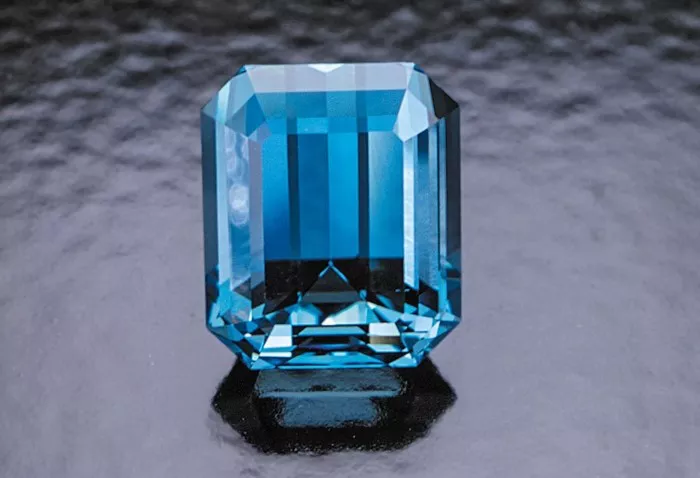Aquamarine, with its serene blue hues reminiscent of the ocean, is a beloved gemstone cherished for its beauty, clarity, and versatility. While aquamarine is known for its range of blue colors, not all shades command the same prices in the gemstone market. In this article, we’ll explore the question: What color aquamarine is most expensive?
Introduction to Aquamarine
Aquamarine is a variety of the mineral beryl, which also includes emerald as another well-known variety. The name “aquamarine” is derived from the Latin words aqua (water) and marina (sea), reflecting the gemstone’s captivating blue color reminiscent of the ocean. Aquamarine’s color can range from pale blue to deep blue-green, with some stones exhibiting a slight greenish or teal hue.
Aquamarine has been prized as a gemstone for centuries, with historical references dating back to ancient civilizations such as the Egyptians and the Romans. It has long been associated with qualities such as tranquility, serenity, and protection, making it a popular choice for jewelry, particularly in rings, necklaces, earrings, and bracelets.
Factors Affecting Aquamarine Value
Several factors influence the value of aquamarine, including color, clarity, carat weight, cut, and origin. Let’s explore each of these factors in more detail:
Color: The color of aquamarine is the most critical factor in determining its value. While aquamarine is known for its blue coloration, the most prized stones exhibit a pure, vivid blue hue with excellent transparency and saturation. These stones are often referred to as “Santa Maria” aquamarines, named after the famous Santa Maria de Itabira mine in Brazil, which produced some of the finest quality aquamarines in the world. Stones with a slight greenish or teal undertone may also be desirable, depending on the intensity and distribution of the color.
Clarity: Clarity refers to the presence of internal characteristics, known as inclusions, within the aquamarine. While some inclusions are acceptable and may even enhance the gemstone’s beauty, stones with excellent clarity and transparency are more valuable. Eye-clean aquamarines with minimal visible inclusions are highly sought after and command higher prices than heavily included specimens.
Carat Weight: As with other gemstones, the size of an aquamarine can significantly affect its value. Larger aquamarines are rarer and thus more valuable than smaller stones. However, the price per carat tends to increase exponentially as the carat weight of the aquamarine increases, meaning that larger stones can be significantly more expensive on a per-carat basis.
Cut: The cut of an aquamarine can greatly impact its beauty, brilliance, and overall value. Well-cut aquamarines exhibit optimal proportions, symmetry, and polish, enhancing their sparkle and light performance. Popular cuts for aquamarines include round, oval, cushion, and emerald cuts, although other fancy shapes may also be available. A high-quality cut can maximize the stone’s color, minimize any potential color zoning or extinction, and create an attractive play of light within the gemstone.
Origin: The geographic origin of an aquamarine can also influence its value and desirability. Aquamarines from certain sources, such as Brazil, are known for their exceptional color and clarity and may command premium prices in the market. Other notable sources of aquamarine include Madagascar, Nigeria, Pakistan, and the United States.
What Color Aquamarine Is Most Expensive?
While all shades of aquamarine are prized for their beauty and clarity, the most expensive color of aquamarine is typically the pure, vivid blue variety known as “Santa Maria” aquamarine. Named after the famous Santa Maria de Itabira mine in Brazil, these aquamarines exhibit a rich, intense blue hue with excellent transparency and saturation. The color is often likened to the clear blue waters of the Caribbean, making it highly desirable among collectors and connoisseurs.
Santa Maria aquamarines are relatively rare in nature, with only a few select sources known to produce stones of this caliber. The Santa Maria de Itabira mine in Brazil was renowned for producing some of the finest quality aquamarines in the world, characterized by their vivid blue color and exceptional clarity. While the mine is no longer operational, aquamarines from this region continue to be highly sought after by gemstone enthusiasts.
Other sources of high-quality aquamarines include Madagascar, which produces stones with a similar intense blue color, as well as Nigeria, Pakistan, and the United States. While aquamarines from these sources may not always reach the same level of intensity as Santa Maria aquamarines, they are still highly prized for their beauty, clarity, and rarity.
Conclusion
In conclusion, the most expensive color of aquamarine is typically the pure, vivid blue variety known as “Santa Maria” aquamarine. Named after the famous mine in Brazil, these aquamarines exhibit a rich, intense blue hue with excellent transparency and saturation, making them highly prized among collectors and connoisseurs. While Santa Maria aquamarines are relatively rare and command premium prices in the market, other sources of high-quality aquamarines, such as Madagascar, Nigeria, Pakistan, and the United States, also produce stones of exceptional beauty and value. Regardless of the specific color, aquamarine continues to captivate gemstone enthusiasts with its serene blue hues and timeless elegance.


